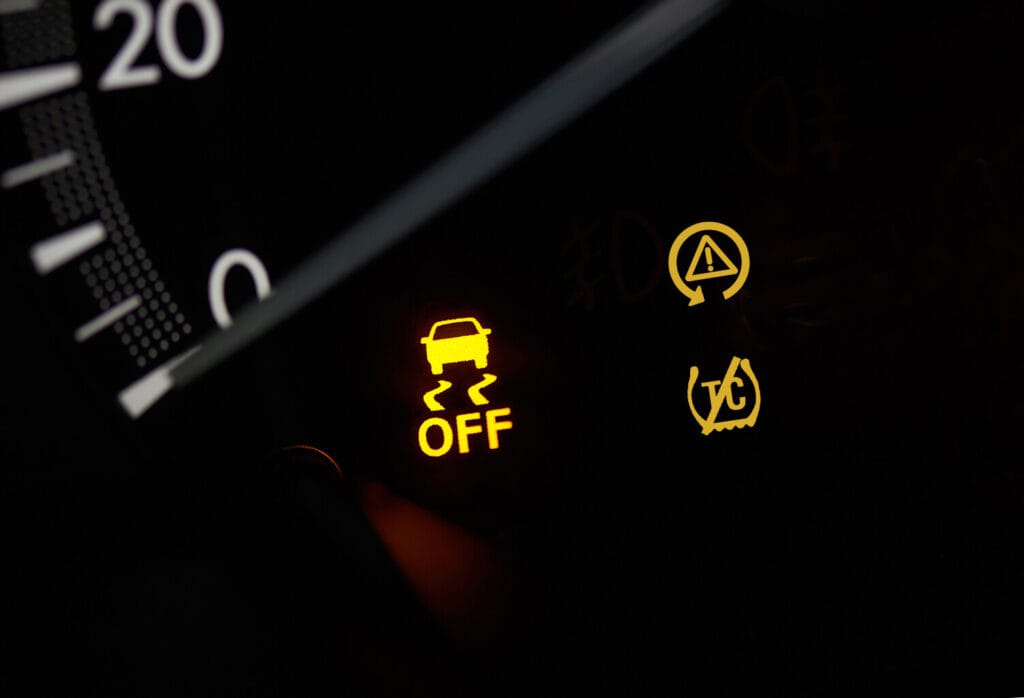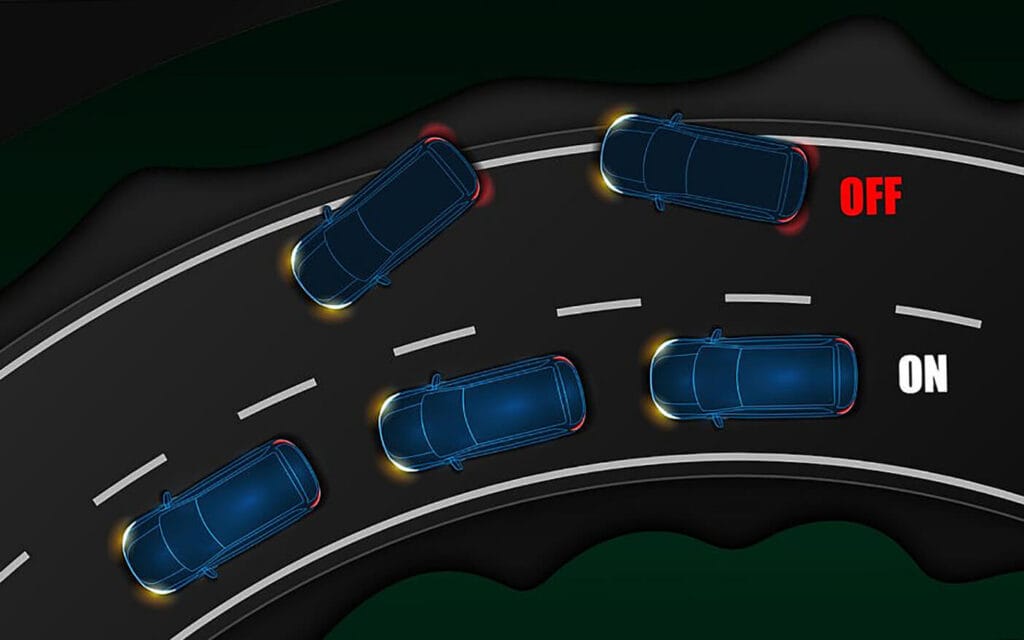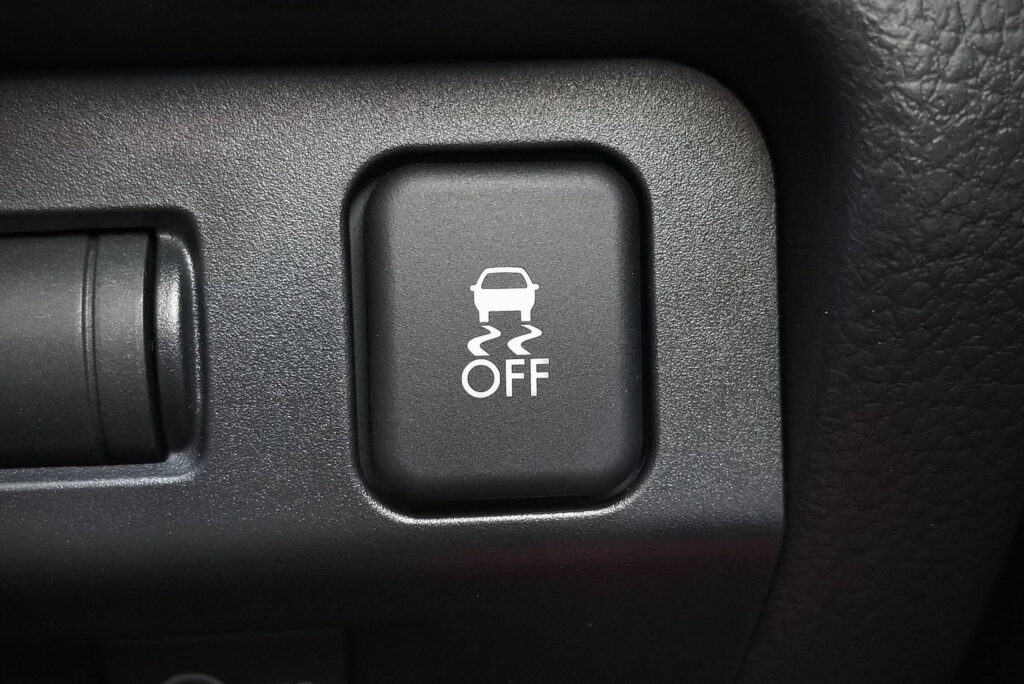Riding Smooth – The Role of Stability Control in Modern Vehicles
In the whirlwind world of vehicular advancements, stability control stands out as one of the most vital safety mechanisms. Acting as the unseen guardian, it continuously monitors the direction your car is moving and the direction you intend it to go. If a mismatch is detected, the system jumps into action, adjusting engine power or applying brake force to specific wheels, ensuring you stay on your intended path.

Decoding the Dashboard: Understanding the Stability Control Light
• Iconic Representation: Typically depicted as a silhouette of a car with squiggly lines (resembling tread marks) trailing behind it, the stability control light is distinct and easy to recognize once you know what to look for.
• System Activation: If the light flickers momentarily, especially during tricky maneuvers or slippery conditions, it’s indicating that the stability control system is actively intervening to help maintain the vehicle’s intended path.
• Fault Alert: A continuously illuminated light, especially in standard driving conditions, is a telltale sign of a potential fault within the system. It might be signaling that the stability control can’t activate when needed.
• Manual Deactivation: In some vehicles, drivers have the option to turn off the stability control (though it’s generally advised against). In such cases, the light would be on to indicate the system’s deactivation.
• Prevention over Cure: While the stability control light’s momentary flash is a sign of the system doing its job, a continuous glow should be addressed promptly. Think of it as the car’s subtle way of asking for a check-up.
• Multifaceted Role: Beyond just signaling active intervention or potential faults, the light also serves as a reminder of the advanced tech working behind the scenes, ensuring safer drives even when road conditions are less than ideal.
Traction vs Stability: Distinguishing Between Control Systems
For many, the world of automobile mechanics is a complex labyrinth, and terms like ‘traction control’ and ‘stability control’ only add to the maze. But fret not, for the difference, while nuanced, is significant and relatively straightforward once deconstructed.
At its core, traction control is your vehicle’s personal trainer, ensuring that the wheels don’t overexert themselves. Think of it this way: on a slick road, it’s easy for wheels to spin excessively during acceleration, leading to potential loss of control. Traction control promptly steps in, limiting this wheel spin, ensuring maximum road grip, and preventing the car from veering off its path.
On the flip side, stability control is more of a guardian angel, silently overseeing and intervening when things go awry. It monitors the vehicle’s direction and compares it to the driver’s intended path. Should it detect a discrepancy, like the car starting to skid sideways or not turning enough, it jumps into action, adjusting engine power or applying brakes to specific wheels, guiding the car back on track.
In essence, while both systems aim to keep the vehicle safe and in control, their methods differ. Traction control focuses on the ground beneath, ensuring optimal grip during acceleration, whereas stability control observes the horizon, ensuring the vehicle stays true to its intended path, come rain, snow, or shine.
Responding to the Light: Safety Implications of Ignoring the Warning
There’s a sense of familiarity as we coast down the roadways, feeling the rhythm of the vehicle, and then suddenly – a light appears on the dashboard, specifically the stability control warning. It’s akin to a delicate murmur, whispering of potential problems ahead. It’s easy to treat this as a minor annoyance, just another indicator in the myriad of lights that occasionally pop up. But doing so might be equivalent to ignoring a life-saving warning.
So, “Is it safe to drive with a stability control light on?” It’s a question that rightfully concerns many drivers. In its essence, this light is an alert, signaling that the stability control system may not be operational. While your vehicle might still run, and short trips might seem unaffected, venturing on longer routes or confronting unpredictable road conditions becomes a gamble. The system, designed to keep your car on its intended path and prevent potential skids or rollovers, might not come to your aid when required. Thus, while the immediate danger might not be glaringly evident, the potential for mishaps amplifies, making it imperative to address the light sooner rather than later.

Troubleshooting and Tweaking: Clearing the Stability Control Light
Navigating the maze of a persistently glowing stability control light can be a tad perplexing. However, a methodical approach can be your guiding star. Here’s a comprehensive guide to troubleshooting:
• Soft Reset: Like rebooting a misbehaving computer, sometimes your car just needs a brief respite. Turn off the ignition, wait for a minute, then restart. This can resolve transient electronic glitches.
• Wheel Sensor Inspection: Dirt, debris, or damage can affect the wheel speed sensors, hampering their ability to read wheel speed accurately. A visual inspection can sometimes identify obvious issues.
• Brake Component Assessment: Stability control is intertwined with your braking system. Check for worn brake pads, damaged rotors, or leaking brake fluid, all of which can impact system functionality.
• Electrical Connections: Loose or corroded connectors can disrupt the stability control system. It’s worth ensuring that all connections, especially those around the system module and sensors, are secure and free from rust.
• Dashboard Alerts: Beyond the stability control light, are there any other warnings on the dashboard? These could provide additional clues. For instance, a brake system light might hint at issues influencing the stability control.
• Consult the Manual: Vehicle manuals often have a troubleshooting section that provides model-specific guidance. Before heading to a mechanic, take a moment to consult this handy resource.
• Professional Diagnosis: If DIY measures don’t do the trick, it might be time for a professional diagnostic scan. Specialized tools can read error codes, offering a clearer picture of underlying issues.
Mastering the Modes: When to Use or Disable Stability Control
Driving is an ever-evolving dance between the driver, the vehicle, and the terrain. The introduction of stability control has undoubtedly made this dance more graceful, especially on conventional roads where it continually works to maintain the car’s equilibrium. But as with any dance, knowing when to lead and when to follow can be crucial.
In conditions like deep snow, sandy patches, or muddy trails, the tight grip of stability control might be too restrictive. The system could perceive the necessary wheel spin in these conditions as a loss of control and work counterproductively to correct it. Hence, disabling stability control temporarily can provide the wheels with a bit more freedom, helping them churn through these challenging terrains. It’s a bit like loosening your tie after a long day – sometimes, a little freedom can make all the difference.
However, it’s crucial to recognize the temporary nature of this adjustment. Once you’re back on firmer, stable ground, reactivating stability control is paramount for safety. And if ever in doubt about its status, your trusty dashboard is there to guide. A specific icon or sometimes even an audible alert ensures you’re never in the dark about whether your stability control is actively watching over your journey.
Power Plays: Stability Control’s Influence on Vehicle Performance
In the automotive world, power often takes center stage. The roar of an engine, the rapid acceleration, the sheer thrill of speed – it’s all intoxicating. But what happens when this power meets a curveball, like a slippery road or an unexpected obstacle? Enter stability control.
So, does stability control play a role in how power is distributed? Absolutely. At its core, stability control is a vigilant overseer, always monitoring the vehicle’s movements. When it senses a potential loss of control, such as during an overly enthusiastic turn or sudden swerve, it jumps into action. By either reducing the engine’s power momentarily or applying brake force to specific wheels, it endeavors to realign the car’s trajectory with the driver’s intended path.
This intervention might momentarily feel like a dip in power or a slight drag, but it’s the system’s way of ensuring safety. Think of it as a seasoned dance instructor guiding a novice – a gentle tug here, a slight push there, all to ensure the dance remains harmonious. While some purists might argue about the purity of raw power, the subtle guidance of stability control ensures that power is harnessed with precision, ensuring both thrill and safety on the road.

Cost Considerations: Repairs and Potential Expenses
Maintaining the stability control system is both a safety measure and an investment. Considering the pivotal role it plays in ensuring safe drives, it’s an expense worth incurring. The road to maintaining the stability control system, while crucial, does have its toll gates.
Here’s a deeper dive into potential costs:
• Routine Checks: Regular diagnostics, while a minor expense, can preempt major issues. Annual checks can help identify wear and tear before they escalate.
• Sensor Replacement: Wheel sensors, being exposed, are susceptible to damage. Replacing one might range from $50 to $250, depending on the vehicle model and part brand.
• System Module: The brain behind stability control, this module can be pricy to replace. Expect costs ranging from $300 to $1,000, a broad range influenced by vehicle specifics and labor rates.
• System Recalibration: Over time or after certain repairs, recalibrating the system might be necessary. This can cost between $50 and $150, ensuring that all components communicate seamlessly.
• Associated Repairs: Issues with the braking or ABS system can indirectly impact stability control. Addressing these might add to your bill, but ensuring all interconnected systems function harmoniously is paramount.
• Labor Costs: Depending on the complexity of the repair and regional labor rates, you might spend between $80 and $150 per hour on professional services.
• Parts vs. Labor: Sometimes, the part might be affordable, but labor-intensive. For instance, accessing a deeply placed module might require dismantling sizable portions of the vehicle, raising labor costs.
Embracing Equilibrium – The Path to Informed Stability Control Management
Stability control isn’t just about lights or systems; it’s about understanding and embracing the balance between vehicle performance and safety. With knowledge comes power, the power to drive with confidence, and the ability to respond proactively. And while we’ve journeyed through the intricacies of stability control, it’s worth noting that sometimes expert intervention is the best course. For those in Canada seeking a touch of professional care, Uchanics mobile mechanic services offers an adept hand in ensuring your stability control and overall vehicle health remain optimal.
